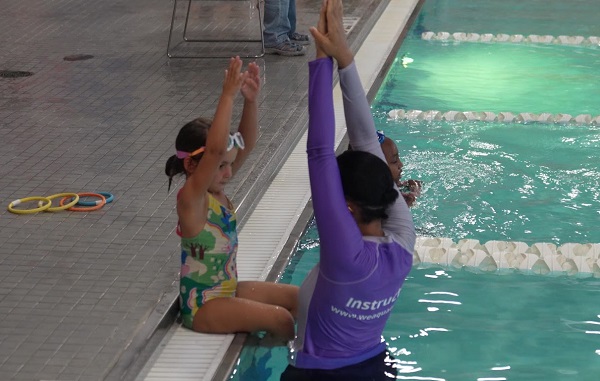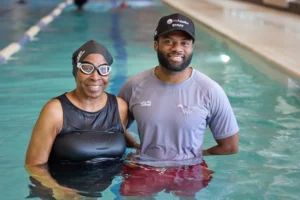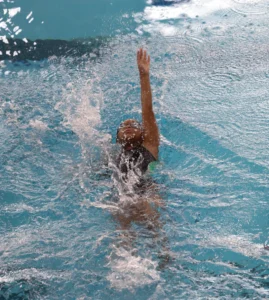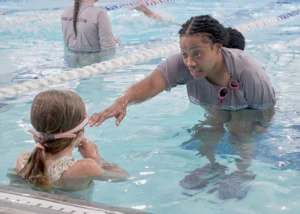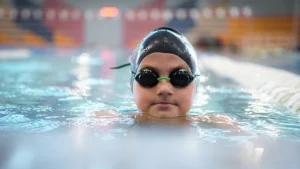Picking a Swim School That Best Promotes Your Progress
When a student starts swimming lessons, one question inevitably arises: How long before I know how to swim? The answer to that question depends on three main factors. Learn more about these factors, as well as how selecting the swim school with the right approach can help speed up your progress.
3 Factors Affecting How Long It Takes You to Learn to Swim
1. Your Starting Point
How quickly you learn to swim depends, obviously, on where you start. Maybe you have some experience in the water. Perhaps you’ve even taken a few swim lessons in the past. If you have that initial base, you’re likely going to progress through lessons more quickly than someone who has no experience.
Similarly, two students might both be starting from square one, but if one is comfortable in the water and another is not, the student with reservations about being in the pool is going to take more time to learn.
“The real learning doesn’t begin until someone is comfortable with being in the water,” says David Worrell, certified swim instructor, certified pool owner, and founder and owner of WeAquatics. “That goes for children and adults.”
2. Frequency of Lessons
Just like riding a bike, swimming is based on muscle memory, and developing those mental pathways takes time. The more frequently you have swim lessons, the more readily you create that motor memory.
An Infant Swimming Resource (ISR) class is only ten minutes, but they typically occur five days a week. At that frequency, most students learn to master the ISR skills in five to seven weeks.
For Learn-To-Swim (LTS) lessons, which occur weekly for thirty minutes per session, some students will learn in a few months. For others, it could take a few years. It depends largely on that student’s personal goals and objectives.
3. Your Definition of Learning to Swim
“Learning to swim” means different things to different people. For some, it’s having correct form when performing each swimming stroke and mastering side breathing.
That’s just one way to look at it, though.
For others, it’s simply being able to get safely and confidently from point A to point B through the water without any assistance: no wall to hold onto, no flotation device, and no one to act as a safety net.
As with so much about swim lessons, it really depends on what the individual student wants to get out of instruction. Therefore, how long it takes you to master swimming depends on what you consider “mastering” swimming.
4 Considerations When Choosing a Swim School
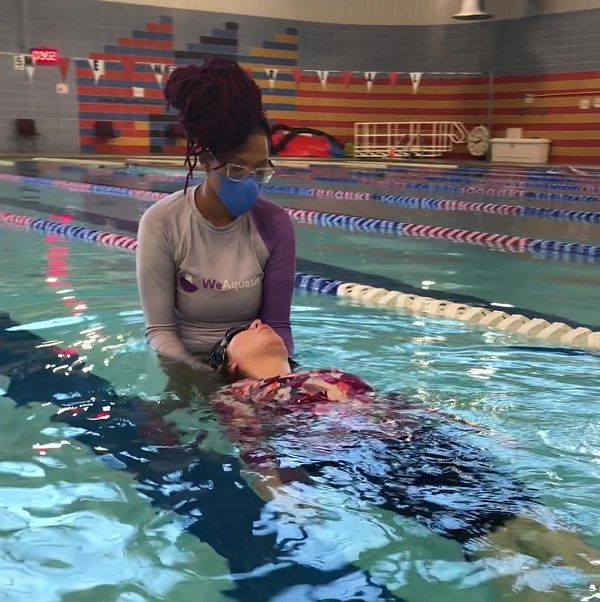
Ready to begin swim lessons? Researching different swim schools? Keeping these four things in mind can help you team up with a swim school that accelerates your progress.
1. Go at Your Own Pace
Whether you’re one of those students who masters all the competitive strokes after two or three months or it takes you years, know that there’s nothing wrong with either end of this spectrum.
When choosing a swim school, opt for the ones that don’t emphasize a set schedule but prioritize reaching individual student goals.
“We’ve had some adults who couldn’t put their faces in the water but learned to freestyle from one end of the pool to the other in eight to ten lessons. We’ve also had adults who weren’t comfortable with being in the shower because water in the face was so disorienting to them,” says Worrell. “Getting people to a place where they can be submerged is when the visible progress begins. It can be a slow ramp-up, but it’s all about using the methods that work for that individual.”
2. Don’t Assume Learning to Swim Is Linear
Many swim schools approach swimming from the framework of “beginner,” “intermediate,” and “advanced,” or they use different levels to indicate a student’s progress. Thinking about swimming in this way, though, can be unhelpful and unproductive.
“A student might be able to do some things that are classified as level five but be challenged by other things that are level one,” says Worrell. “Learning to swim is not a linear process, and a swim instructor should always strive to meet students where they are.”
Swim schools and swim coaches who approach teaching this way can help students progress more quickly to their goals.
3. Look for Customization in Your Lessons
It should be up to the swim instructor to create a custom plan for each student. That means blowing bubbles in the water might be step one for some students, but that won’t make sense for others. Everything should depend on the individual.
“A student should start working on whatever is going to make them more confident in the water,” says Worrell. “We do have a skills checklist sorted by ‘advanced,’ ‘intermediate,’ and ‘beginner,’ but that’s not to say we have to teach in that order. It’s all about customization.”
4. Track Your Progress Online
Whether you’re tracking your own progress or checking how a child is advancing through lessons, there should be an easy way for you to monitor a given student’s swimming skills checklist. At WeAquatics, all instructors update their students’ skills checklists based on what those students have mastered, and this information is stored in our customer portal.
This provides two major benefits. One is transparency. If you’re enrolled in lessons, you’ll be able to see where you are at with a variety of skills and what areas still need attention. Two, if you ever need a substitute instructor for any reason, even someone who has never seen you can assess your chart and then confidently administer a lesson he or she knows will benefit you.
Do you have questions about the process of learning how to swim? Want more guidance on how to select the right swim school? Feel free to reach out. We’re always happy to help!

